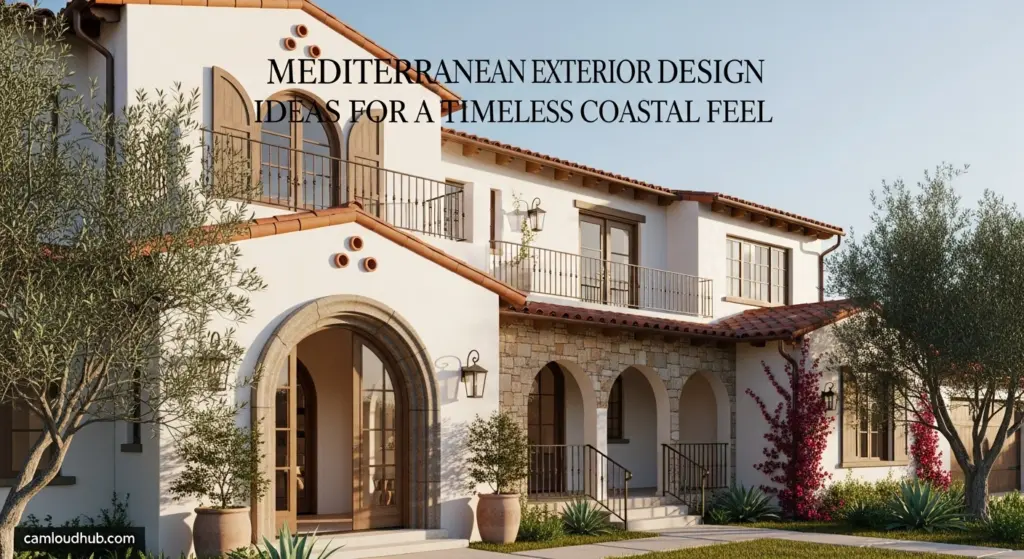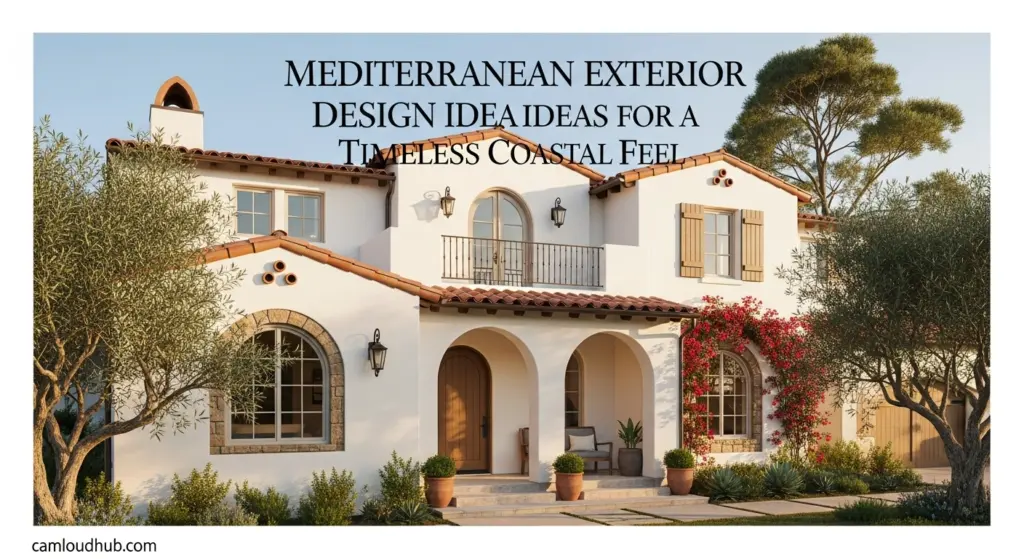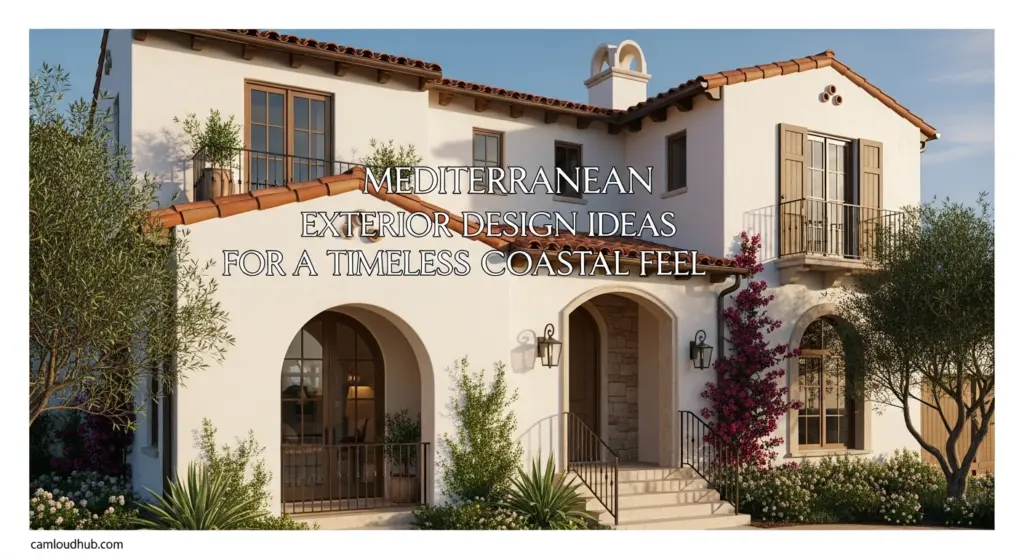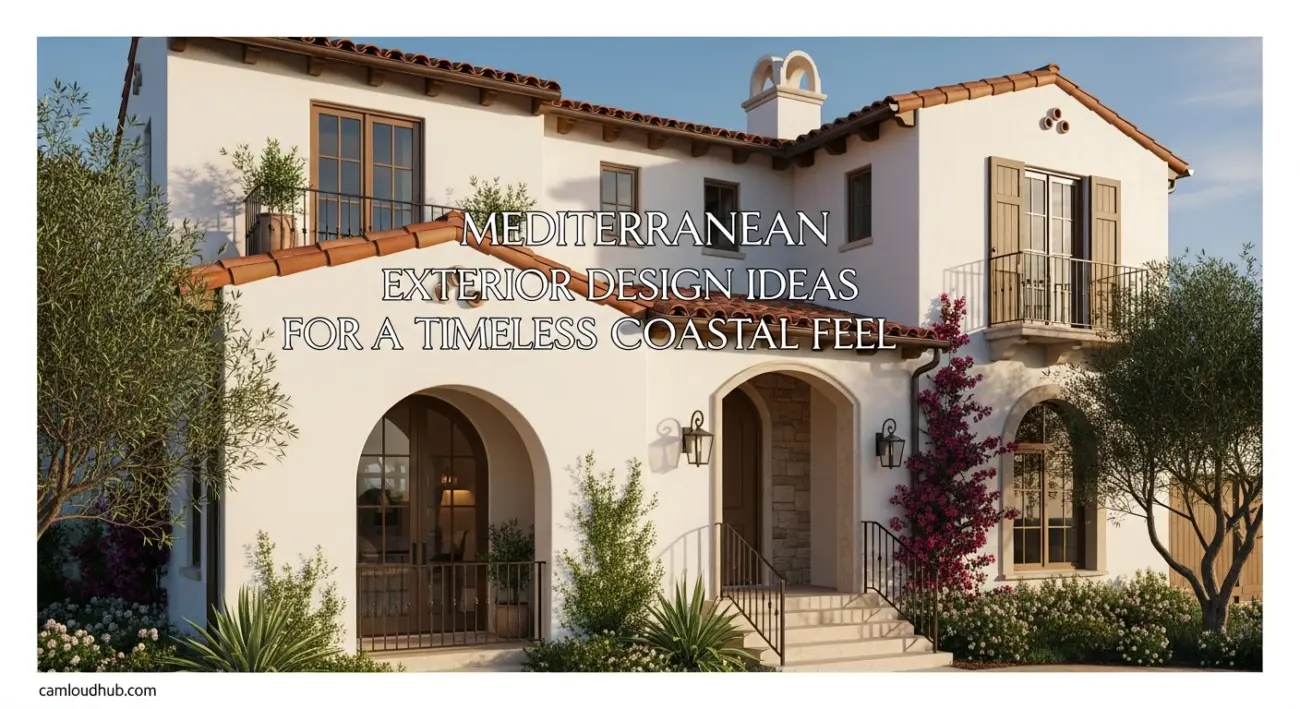Understanding the Essence of Mediterranean Exterior Design
Mediterranean Exterior Design Ideas for a Timeless Coastal Feel – Mediterranean exterior design is more than just a trend; it’s an enduring aesthetic that draws inspiration from the coastal regions of Greece, Italy, Spain, and North Africa. These regions share a common climate – warm, sunny, and dry – which has profoundly influenced the architectural styles and design choices. At its core, Mediterranean exterior design emphasizes natural materials, earthy tones, and a seamless connection between indoor and outdoor spaces. It’s about creating a welcoming and relaxing environment that celebrates the beauty of simplicity.

Key Architectural Elements for a Mediterranean Look
The architectural foundation is crucial for achieving an authentic Mediterranean feel. While a complete remodel may not always be feasible, incorporating key architectural elements can significantly transform your home’s exterior.
Stucco Walls: The Signature Texture
Stucco is the defining material of Mediterranean architecture. Its textured surface adds depth and visual interest, while its ability to reflect sunlight helps keep interiors cool. The traditional color is white or off-white, but warm earthy tones like terracotta, ochre, and beige are also commonly used. When applying stucco, consider the texture you want to achieve. A rougher texture evokes a rustic, old-world charm, while a smoother finish offers a more contemporary look. Remember proper preparation is vital when applying stucco. This will assure a lasting beauty to your home.
Arches and Curves: Adding Structural Grace
Arches are another hallmark of Mediterranean architecture, adding a touch of elegance and sophistication. They can be incorporated into doorways, windows, and covered walkways to create a visually appealing and structurally sound design. Curved details soften the linear lines of the architecture, creating a more organic and inviting aesthetic. Consider arched doorways, rounded windows, or curved balconies. These details add a sense of fluidity and grace to the overall design. It is also worth considering the size of these curved features relative to the existing architectural framework. Too large, and they risk overwhelming the design; too small, and their nuance can go unnoticed.
Tiled Roofs: A Mediterranean Crown
Clay tile roofs are instantly recognizable and contribute significantly to the Mediterranean aesthetic. The warm, earthy tones of the tiles complement the stucco walls and create a cohesive and visually appealing exterior. While traditional terracotta tiles are the most common choice, other colors like brown, grey, and even blue can be used to create a unique and personalized look. The roofing material should also be durable, helping to deal with the elements. The type of Mediterranean clay tile is also available in many variations to fit a specific style.
Columns and Pillars: Adding Grandeur and Support
Columns and pillars are often used to add grandeur and structural support to verandas, balconies, and entryways. They can be made of stone, concrete, or wood and are often adorned with decorative details. Columns can be simple and unadorned for a more minimalist look or elaborately decorated with carvings and moldings for a more formal feel. When integrating columns, consider the scale and proportions in relation to the overall architectural framework, ensuring that they elevate rather than overshadow the design.
Landscaping: Creating a Coastal Oasis
The landscaping plays a crucial role in creating a Mediterranean-inspired exterior. The goal is to create a lush and inviting outdoor space that complements the architectural elements and evokes the feeling of the Mediterranean coast.
Olive Trees: The Symbol of the Mediterranean
Olive trees are iconic symbols of the Mediterranean and are a must-have for any Mediterranean-inspired landscape. They are drought-tolerant, evergreen, and provide beautiful, silvery foliage. Olive trees can be planted in the ground or in large pots, making them versatile for different landscapes and garden configurations. Be mindful of their mature size when planting for long-term sustainability.
Citrus Trees: Fragrant and Fruitful
Citrus trees, such as lemon, orange, and grapefruit, are another essential element of Mediterranean landscaping. They provide fragrant blossoms in the spring and colorful fruits in the winter, adding both beauty and functionality to the garden. Citrus trees thrive in warm climates and well-drained soil. If citrus trees are not hardy for your zone, you can keep them in pots and bring them indoors for winter.
Lavender and Herbs: Aromatic Touches
Lavender, rosemary, thyme, and other aromatic herbs are commonly found in Mediterranean gardens. They add beauty, fragrance, and culinary value to the landscape. These herbs are drought-tolerant and thrive in sunny locations. Lavender can be planted along walkways or in borders, while rosemary and thyme can be used as ground cover or in rock gardens. These herbs are also an excellent resource for bees and other pollinators.
Colorful Flowers: Adding Vibrancy
While the Mediterranean landscape is often characterized by drought-tolerant plants and muted colors, adding pops of color with vibrant flowers can enhance the overall aesthetic. Bougainvillea, geraniums, petunias, and hibiscus are popular choices. Red, pink, purple, and orange flowers evoke the Mediterranean spirit. Incorporating flowers to contrast the muted greens and earth tones is an excellent way to create a visual appeal.
Gravel Pathways and Patios: A Natural Ground Cover
Gravel pathways and patios are a common feature in Mediterranean landscapes. They are permeable, drought-tolerant, and provide a natural and rustic aesthetic. The color and size of the gravel can be chosen to complement the surrounding landscape and architectural elements. Consider using larger stones as accents and borders for visual interest. Gravel pathways also contribute to drainage, minimizing water runoff and soil erosion.
Colors and Materials: Capturing the Mediterranean Palette
The color palette and materials used in Mediterranean exterior design are crucial for creating an authentic and harmonious look. The goal is to evoke the warmth of the sun, the earthiness of the soil, and the freshness of the sea.
Earthy Tones: The Foundation of the Palette
Earthy tones, such as terracotta, ochre, beige, and brown, form the foundation of the Mediterranean color palette. These colors are warm, inviting, and reflect the natural environment. They can be used on walls, roofs, and paving materials to create a cohesive and harmonious look. Earthy tones also offer a sense of timelessness and stability.
White and Off-White: Reflecting the Sun
White and off-white are also commonly used in Mediterranean exterior design, particularly on stucco walls. These colors reflect sunlight and help keep interiors cool. They also create a clean and sophisticated aesthetic. White and off-white can be used as a primary color or as an accent color to highlight architectural details.

Blue Accents: Echoing the Sea
Blue accents, in shades of turquoise, cobalt, and sky blue, are often used to evoke the sea. They can be incorporated into doors, shutters, window frames, and decorative elements. Blue accents add a refreshing and vibrant touch to the otherwise earthy color palette. The specific shade of blue can be adjusted depending on the desired mood and aesthetic.
Natural Stone: A Timeless Material
Natural stone, such as limestone, travertine, and marble, is a timeless material that is commonly used in Mediterranean exterior design. It can be used for paving, walls, and decorative elements. Natural stone adds texture, durability, and a sense of luxury to the landscape. The irregular patterns and variations in color create a unique aesthetic.
Wood: Adding Warmth and Texture
Wood is another important material for Mediterranean exterior design. It can be used for pergolas, fences, shutters, and doors. Wood adds warmth, texture, and a touch of rusticity to the exterior. Consider using reclaimed wood for a more sustainable and authentic look.
Outdoor Living Spaces: Embracing the Mediterranean Lifestyle
Creating inviting outdoor living spaces is a key aspect of Mediterranean exterior design. The goal is to create an area where you can relax, entertain, and enjoy the beauty of the outdoors.
Patios and Courtyards: Extending the Living Space
Patios and courtyards are essential elements of Mediterranean outdoor living. They provide a space for dining, lounging, and socializing. Patios can be paved with natural stone, brick, or tile, while courtyards can be landscaped with plants and water features. It is important to consider the layout of the patio and courtyard to maximize sunlight and privacy.
Pergolas and Arbors: Creating Shaded Retreats
Pergolas and arbors provide shade and create a sense of enclosure in outdoor living spaces. They can be constructed from wood, metal, or stone and can be adorned with climbing plants like vines and roses. Pergolas not only provide shade but act as a natural extension of your indoor space.
Outdoor Kitchens: Al Fresco Dining
Outdoor kitchens are becoming increasingly popular in Mediterranean-inspired homes. They allow you to prepare and enjoy meals outdoors, taking full advantage of the warm weather. Outdoor kitchens can include grills, ovens, sinks, and countertops. When designing an outdoor kitchen, consider the layout, materials, and appliances that best suit your needs.
Fire Pits and Fireplaces: Warmth and Ambiance
Fire pits and fireplaces create warmth and ambiance in outdoor living spaces. They provide a gathering place for family and friends to enjoy cool evenings. Fire pits can be built-in or portable and can be fueled by wood, gas, or propane. A fire pit helps to create a focal point in an outdoor setup.
Water Features: Adding Tranquility
Water features, such as fountains, ponds, and waterfalls, add tranquility and beauty to outdoor living spaces. They provide a soothing sound and attract birds and other wildlife. Water features can be simple or elaborate and can be integrated into the landscape in various ways. The use of recirculating pumps can help to minimize water usage.
Lighting: Illuminating the Mediterranean Night
Lighting plays a crucial role in creating the right ambiance and functionality in your Mediterranean-inspired outdoor space. The goal is to create a warm and inviting atmosphere that enhances the beauty of the landscape and architectural elements.
Warm Lighting: Creating a Cozy Atmosphere
Warm lighting, with a color temperature of 2700-3000K, creates a cozy and inviting atmosphere. It enhances the warmth of the earthy tones and creates a comfortable environment for relaxation and entertainment. Warm-colored lights also create a soothing ambiance.
Path Lighting: Enhancing Safety and Aesthetics
Path lighting is essential for illuminating walkways and pathways, enhancing safety and aesthetics. Consider using low-voltage lights that are energy-efficient and easy to install. Path lighting should be strategically placed to highlight architectural features.
Accent Lighting: Highlighting Architectural Details
Accent lighting is used to highlight architectural details, such as columns, arches, and textured walls. It adds depth and dimension to the exterior and creates a visually appealing effect. Consider using spotlights to spotlight specific features that provide visual interests around the home.
String Lights: Adding Festive Charm
String lights add a festive and romantic charm to outdoor spaces. They can be hung from pergolas, trees, or fences to create a magical ambiance. String lights can also create a visual boundary around specific portions of the outdoor space.
Lanterns and Candles: A Traditional Touch
Lanterns and candles add a traditional and romantic touch to Mediterranean outdoor lighting. They can be placed on tables, walls, or steps to create a warm and inviting glow. Opt for candles with a long burn time for extended periods of enjoyment.
Furniture and Decor: Completing the Mediterranean Look
The furniture and decor you choose will complete your Mediterranean exterior design and create a cohesive and inviting outdoor space. The goal is to select pieces that are comfortable, stylish, and durable.
Wrought Iron Furniture: A Classic Choice
Wrought iron furniture is a classic choice for Mediterranean outdoor spaces. It is durable, stylish, and adds a touch of elegance to the exterior. Wrought iron furniture can be used for dining tables, chairs, benches, and decorative elements.
Rattan and Wicker: Adding Natural Texture
Rattan and wicker furniture add natural texture and warmth to outdoor spaces. They are lightweight, comfortable, and perfect for creating a relaxed and inviting atmosphere. Rattan and wicker furniture work well in covered areas exposed to minimal direct rainfall.
Outdoor Cushions and Pillows: Comfort and Style
Outdoor cushions and pillows add comfort and style to outdoor furniture. Choose fabrics that are durable, water-resistant, and fade-resistant. Incorporate colors and patterns that complement the Mediterranean color palette. Consider mixing and matching textures and patterns.
Terracotta Pots: A Mediterranean Staple
Terracotta pots are a staple of Mediterranean gardens. They add a rustic and earthy touch to the landscape and can be used to display plants, herbs, and flowers. Terracotta adds a traditional charm.
Decorative Accents: Personalizing the Space
Decorative accents, such as sculptures, fountains, and pottery, personalize the outdoor space and add character. Choose pieces that reflect your personal style and complement the Mediterranean aesthetic. Adding elements like an Old World map can add an eclectic flair.
Adapting Mediterranean Design to Different Climates
While Mediterranean exterior design is ideally suited to warm, dry climates, it can be adapted to suit a variety of environments. The key is to choose materials, plants, and design elements that are appropriate for your local climate.
Dealing with Humidity: Moisture-Resistant Materials
If you live in a humid climate, choose moisture-resistant materials for your outdoor furniture, decks, and patios. Teak, cedar, and composite materials are excellent choices for humid environments. Proper ventilation is also crucial for preventing mold and mildew growth.
Adapting to Colder Climates: Hardy Plants and Insulation
If you live in a colder climate, choose hardy plants that can withstand harsh winters. Conifers, evergreen shrubs, and cold-tolerant perennials are good options. Consider adding insulation to your walls and roofs to improve energy efficiency.
Sustainable Considerations for Mediterranean Exteriors
Incorporating sustainable elements into your Mediterranean exterior design enhances its longevity and environmental friendliness.
Xeriscaping: Water-Wise Landscaping
Xeriscaping is a water-wise landscaping technique that uses drought-tolerant plants and efficient irrigation methods to minimize water consumption. It is an ideal choice for Mediterranean gardens in arid climates.
Permeable Paving: Reducing Runoff
Permeable paving allows rainwater to seep into the ground, reducing runoff and replenishing groundwater supplies. It is an environmentally friendly alternative to traditional concrete or asphalt paving.
Solar Panels: Harnessing Solar Energy
Solar panels can be integrated into the roof or pergola to generate clean energy and reduce your reliance on fossil fuels. They are a sustainable and cost-effective way to power your home and outdoor living spaces.
Case Studies: Inspiring Mediterranean Transformations
Examining successful Mediterranean exterior design transformations can provide inspiration and practical insights.
Example 1: A Modern Mediterranean Makeover
A suburban home underwent a transformation with the addition of stucco walls, a clay tile roof, and arched windows. A gravel patio with a pergola and outdoor kitchen was added to create an inviting outdoor living space.
Example 2: A Rustic Mediterranean Retreat
A hillside property was converted into a rustic Mediterranean retreat with stone walls, a tiled courtyard, and olive trees. The landscaping incorporated drought-tolerant plants and a natural stone fountain.
Common Mistakes to Avoid in Mediterranean Exterior Design
Avoiding common design pitfalls ensures a successful transformation.
Overdoing the Details: Simplicity is Key
One common mistake is overdoing the details. Mediterranean exterior design is about simplicity and elegance. Avoid cluttering the space with too many decorative elements.
Ignoring the Climate: Choosing Inappropriate Materials
Choosing materials that are not appropriate for your climate can lead to costly repairs and maintenance.
Neglecting the Landscaping: Creating a Disconnected Space
Neglecting the landscaping can create a disconnected and uninviting outdoor space. Ensure that the landscaping complements the architectural elements.
DIY Mediterranean Design Projects
Embark on your own hands-on creations to infuse more Mediterranean flair.
Building a Pergola: Creating Shade and Ambiance
Building a pergola is a great DIY project that can add shade and ambiance to your outdoor space.
Creating a Gravel Pathway: Adding a Rustic Touch
Creating a gravel pathway is a simple and affordable DIY project that can add a rustic touch to your garden.
Planting a Herb Garden: Aromatic and Functional
Planting a herb garden is a rewarding DIY project that can provide fresh herbs for cooking and add fragrance to your outdoor space.
Hiring Professionals: When to Seek Expert Help
While DIY projects can be fulfilling, certain aspects of Mediterranean exterior design may require professional expertise.
Architectural Design: Ensuring Structural Integrity
Architectural design requires professional expertise for structural integrity and aesthetics.
Landscaping Design: Creating a Harmonious Space
Landscaping design requires professional expertise for planting choices, layout, and irrigation.
Construction and Installation: Ensuring Quality
Construction and installation require professional expertise for proper execution and longevity.
Budgeting for Your Mediterranean Exterior Transformation
Proper financial planning ensures a smooth and stress-free renovation journey.
Setting a Realistic Budget: Researching Costs
Researching costs for materials, labor, and permits is crucial for setting a realistic budget.
Prioritizing Projects: Focusing on Key Elements
Focusing on key elements will help to reduce costs while achieving a desired look.
Seeking Multiple Quotes: Comparing Prices
Obtaining multiple quotes from contractors and suppliers is essential for comparing prices.
Maintaining Your Mediterranean Exterior: Long-Term Care
Regular care ensures the longevity and beauty of your Mediterranean exterior.
Cleaning and Sealing: Protecting Surfaces
Cleaning and sealing surfaces, such as stucco walls and stone patios, protects them from the elements.
Pruning and Trimming: Maintaining Plant Health
Pruning and trimming plants and shrubs prevents overgrowth and disease.
Inspecting for Damage: Addressing Issues Promptly
Inspecting for damage from pests and water can help address issues promptly to prevent major problems.

The Enduring Appeal of Mediterranean Exterior Design
Mediterranean exterior design offers a timeless appeal due to its connection with nature.
Warm, Relaxing, and Inviting: A Timeless Aesthetic
The warm and inviting nature of the design creates a sense of relaxation.
A Connection to Nature: Embracing the Outdoors
The design embraces the outdoors with lush gardens and outdoor living spaces.
A Celebration of Simplicity: Elegant and Understated
The emphasis on simplicity makes the space elegant and understated.
Conclusion
Bringing the charm of the Mediterranean to your home’s exterior is an achievable dream. By understanding the core principles of Mediterranean exterior design, from the architectural elements and landscaping to the colors, materials, and lighting, you can create a timeless coastal feel that will enhance your lifestyle and add lasting value to your property. It’s about creating a captivating space that invites relaxation, connection, and an appreciation for the simple pleasures of life under the sun. Remember that the Mediterranean style is not just a design – it’s a way of life.


